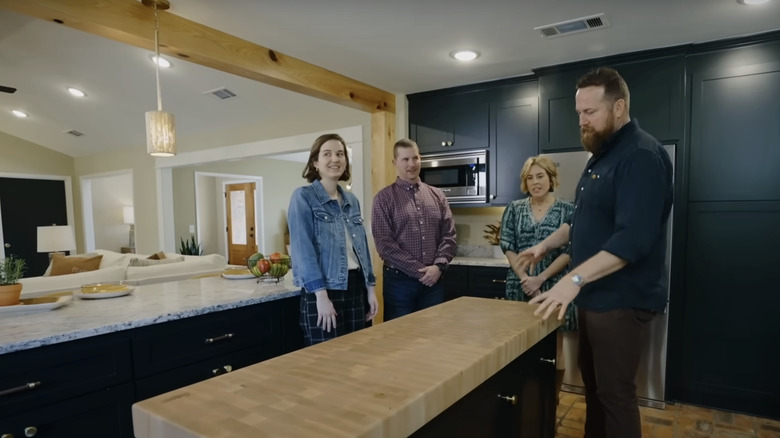HGTV's Ben Napier Steps Up His Butcher Block Game With A Stunning Home Town Reveal
Ben Napier has always been known for his woodwork on "Home Town," but one reveal featured a particularly jaw-dropping butcher block surface. In Season 7, Episode 16, Ben and Erin Napier were tasked with upgrading and renovating a Mid-century home that was already brimming with character. Ben and Erin leaned into the era, as mid-century design will never go out of style. Rather than the traditional butcher block countertops, Ben had the creative idea of building a kitchen island-style workspace using end grain. This kind of hardwood countertop is created using only the end grain of the wood, resulting in a more resilient surface.
During the episode, the contractors commended Ben on how the choice of end grain blocks mimicked the appearance of the surrounding brick floors. This emphasizes the importance of utilizing geometry to create a cohesive space. Even if you don't want to commit to an entire island or countertop covered in butcher block, you can purchase a cutting board in the end grain style on Ben and Erin's own website, Scotsman USA. However, these surfaces are popular and they sell out fast. Scotsman USA also offers a traditional butcher block material if you need to cover a larger space.
The pros and cons of butcher block countertops
While Ben and Erin have always been fans of this timeless material, butcher block countertops might not be for everyone. A recurring issue with butcher block countertops is that they are not heat-resistant. Unfortunately, the end grain variation won't solve this issue. However, if your main concern is longevity, Ben explains in the episode: "This is an end grain maple butcher block. It's more durable, it pulls moisture in, it won't damage your knives or anything."
End grain countertops can also lessen the risk of mold or mildew that comes with traditional butcher block countertops. As the knife cuts into the surface, it squeezes out the moisture and tiny pieces of food. This helps prevent the surface from harboring harmful bacteria. However, it is still good practice to dry the surface promptly and clean any area that has come into contact with raw meat. In order to avoid these risks altogether, you can always use an additional cutting board. It might be tempting to cut and prepare food directly on your countertops or kitchen island, but using a supplementary cutting surface will eliminate any chance for issues to arise in the future.

